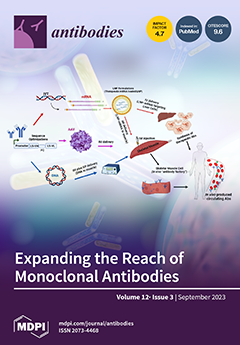Open AccessArticle
Comparison between Neutralization Capacity of Antibodies Elicited by COVID-19 Natural Infection and Vaccination in Indonesia: A Prospective Cohort
by
Sitti Nurisyah, Mitsuhiro Iyori, Ammar Abdurrahman Hasyim, Akihiko Sakamoto, Hinata Hashimoto, Kyouhei Yamagata, Saya Yamauchi, Khaeriah Amru, Kartika Hardianti Zainal, Irfan Idris, Shigeto Yoshida, Irawaty Djaharuddin, Din Syafruddin, Agussalim Bukhari, Puji Budi Setia Asih and Yenni Yusuf
Viewed by 1708
Abstract
Background: To fight the COVID-19 pandemic, immunity against SARS-CoV-2 should be achieved not only through natural infection but also by vaccination. The effect of COVID-19 vaccination on previously infected persons is debatable. Methods: A prospective cohort was undergone to collect sera from unvaccinated
[...] Read more.
Background: To fight the COVID-19 pandemic, immunity against SARS-CoV-2 should be achieved not only through natural infection but also by vaccination. The effect of COVID-19 vaccination on previously infected persons is debatable. Methods: A prospective cohort was undergone to collect sera from unvaccinated survivors and vaccinated persons—with and without COVID-19 pre-infection. The sera were analyzed for the anti-receptor binding domain (RBD) titers by ELISA and for the capacity to neutralize the pseudovirus of the Wuhan-Hu-1 strain by luciferase assays. Results: Neither the antibody titers nor the neutralization capacity was significantly different between the three groups. However, the correlation between the antibody titers and the percentage of viral neutralization derived from sera of unvaccinated survivors was higher than that from vaccinated persons with pre-infection and vaccinated naïve individuals (Spearman correlation coefficient (
r) = −0.8558; 95% CI, −0.9259 to −0.7288),
p < 0.0001 vs. −0.7855; 95% CI, −0.8877 to −0.6096,
p < 0.0001 and −0.581; 95% CI, −0.7679 to −0.3028,
p = 0.0002, respectively), indicating the capacity to neutralize the virus is most superior by infection alone. Conclusions: Vaccines induce anti-RBD titers as high as the natural infection with lower neutralization capacity, and it does not boost immunity in pre-infected persons.
Full article
►▼
Show Figures






